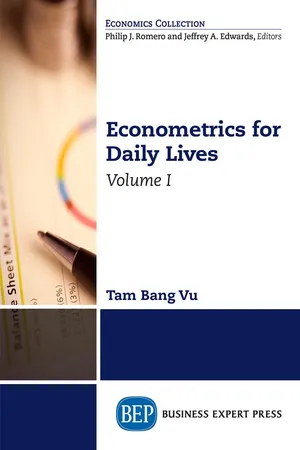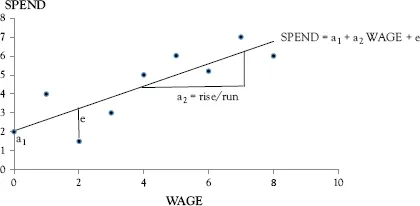
eBook - ePub
Econometrics for Daily Lives, Volume I
Tam Bang Vu
This is a test
- 121 pages
- English
- ePUB (mobile friendly)
- Available on iOS & Android
eBook - ePub
Econometrics for Daily Lives, Volume I
Tam Bang Vu
Book details
Book preview
Table of contents
Citations
About This Book
Econometrics for Daily Lives helps you collect data and analyze the relationship among numerous factors facing you in your everyday activities. This first volume comprises two parts. Part I reviews basic statistics and introduces the most elementary topics in econometrics, including simple regressions and multiple regressions. Part II discusses several problems arisen in data analyses, one problem at a time, so that you can learn to deal with each problem without having to master advanced topics in econometrics. The volume is full of examples and practical guidance on how to perform data analyses using Microsoft Excel.
Frequently asked questions
How do I cancel my subscription?
Can/how do I download books?
At the moment all of our mobile-responsive ePub books are available to download via the app. Most of our PDFs are also available to download and we're working on making the final remaining ones downloadable now. Learn more here.
What is the difference between the pricing plans?
Both plans give you full access to the library and all of Perlego’s features. The only differences are the price and subscription period: With the annual plan you’ll save around 30% compared to 12 months on the monthly plan.
What is Perlego?
We are an online textbook subscription service, where you can get access to an entire online library for less than the price of a single book per month. With over 1 million books across 1000+ topics, we’ve got you covered! Learn more here.
Do you support text-to-speech?
Look out for the read-aloud symbol on your next book to see if you can listen to it. The read-aloud tool reads text aloud for you, highlighting the text as it is being read. You can pause it, speed it up and slow it down. Learn more here.
Is Econometrics for Daily Lives, Volume I an online PDF/ePUB?
Yes, you can access Econometrics for Daily Lives, Volume I by Tam Bang Vu in PDF and/or ePUB format, as well as other popular books in Volkswirtschaftslehre & Ökonometrie. We have over one million books available in our catalogue for you to explore.
Information
Subtopic
ÖkonometriePART I
Elementary Topics
This part contains three chapters:
• Chapter 1 Introduction
• Chapter 2 Simple Linear Regressions
• Chapter 3 Multiple Linear Regressions
CHAPTER 1
Introduction
“It is a normal distribution!!” exclaims Booka, the owner of Bookwebki. Invo the investor is curious, “What is that?” Booka replies, “I tried to draw a histogram of my store’s sales on a type of book with different designs, and it came up very close to a normal distribution.” We all look at the teacher, “What is a histogram?” Professor Metric, our teacher, responds cheerfully that we will learn these basic concepts very soon and that by the time we finish this chapter, we will be able to do the following:
1. Discuss the nature of an econometric model.
2. Explain basic concepts of probability.
3. Distinguish inferential statistics from descriptive statistics.
4. Perform simple data manipulations and calculations using Excel.
He then leads us into the first section of the lecture.
What Is Econometrics?
Econometrics is a branch of economics that uses statistical methods and mathematics to estimate any relationship in everyday life, test any hypothesis and theory, evaluate business strategies, and implement public policies. There is a big difference between a theoretical model and an econometric model. A theoretical model studies hypothetical relations between variables using a general function. For example, let the variable WAGE represent the average weekly wage of a person and the variable SPEND represent his or her spending on nondurable goods and services such as food, clothes, haircuts, and so on. Then we can write a theoretical model as

where a1 is a constant representing the average nondurable spending by a person with WAGE = 0, and a2 is the change in spending due to a unit change in personal wage.
An econometric model quantifies that relationship. In order for you to estimate the value of the parameters a’s and test for their significance, the model is written in a particular way as follows:

where a1 is the intercept and a2 is the slope of the regression line. The random error, e, accounts for a set of unobserved factors that might affect SPEND other than WAGE or any random component in the model. Figure 1.1 illustrates this relationship, with a1 as the intercept, a2 as the slope of the regression line, and e as the distance from an actual data point to the regression line.
The variable on the left-hand side is called the dependent variable (SPEND in this case), and the variable on the right-hand side is called the independent variable if we have only one variable on the right-hand side (WAGE in this case) or explanatory variables if we have more than one variable on the right-hand side.

Figure 1.1 Relationship between wage and spending
Basic Steps
There are usually three basic steps in econometric research:
Step 1: | Selecting the Model Depending on the problem and the availability of the information, an appropriate model should be decided. In the preceding example, our model is specified in Equation (1.2). |
Step 2: | Collecting and Analyzing Data Data can be collected directly by the user (primary data) or by someone other than the user (secondary data). Data analyses consist of constructing data plots, obtaining descriptive statistics, and performing certain techniques to quantify the relationship between a dependent variable and one or more explanatory variables. |
Step 3: | Interpreting the Results Evaluations of the results are performed based on hypothesis testing and other measures. Based on the interpretations of the results, implications concerning economic theory and practical policies are drawn. |
Statistics Primer
Professor Metric emphasizes that statistics provides important tools for data analysis and you can spend your whole life studying it. However, some basic knowledge of statistics, discussed in the following section, is enough to understand econometric techniques in part one. More concepts will be introduced later.
Probability
Probability is the likelihood of an event occurring and is measured by the ratio...
Table of contents
- Cover
- Half-title Page
- Title Page
- Copyright
- Abstract
- Contents
- Preface
- Acknowledgments
- Part I Elementary Topics
- Part II Intermediate Topics
- Bibliography
- About the Author
- Index
- Backcover
Citation styles for Econometrics for Daily Lives, Volume I
APA 6 Citation
Vu, T. B. (2017). Econometrics for Daily Lives, Volume I ([edition unavailable]). Business Expert Press. Retrieved from https://www.perlego.com/book/547119/econometrics-for-daily-lives-volume-i-pdf (Original work published 2017)
Chicago Citation
Vu, Tam Bang. (2017) 2017. Econometrics for Daily Lives, Volume I. [Edition unavailable]. Business Expert Press. https://www.perlego.com/book/547119/econometrics-for-daily-lives-volume-i-pdf.
Harvard Citation
Vu, T. B. (2017) Econometrics for Daily Lives, Volume I. [edition unavailable]. Business Expert Press. Available at: https://www.perlego.com/book/547119/econometrics-for-daily-lives-volume-i-pdf (Accessed: 14 October 2022).
MLA 7 Citation
Vu, Tam Bang. Econometrics for Daily Lives, Volume I. [edition unavailable]. Business Expert Press, 2017. Web. 14 Oct. 2022.